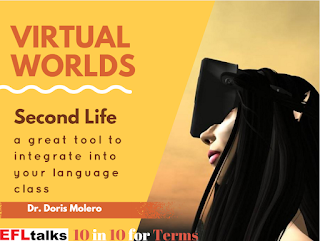Creative Ways to Develop Digital Literacy and Language Skills by Connecting Reading and Writing
Roleplay, Emoting, and Fanfiction for Storytelling
The world has changed because of COVID and one of the most important changes is that more educators and students have started exploring different digital tools that allow them to keep on learning. One way to do this is to use immersive worlds, people can use avatars to socially interact in immersive settings for fun, work, or learning. Traditionally most people have used them to play games.
| Roleplaying in Avilion. Molero (2020) |
One of the most popular digital and creative linguistic practices in Virtual worlds like Second Life or OpenSim is Roleplaying. More than a game roleplaying is an excellent opportunity for students and educators to meet other people, belong to a community, learn about different cultures, and develop their digital literacy and English language skills.
| Role-playing and Emoting for Language learning in Virtual Worlds. Molero (2017) |
Role-playing and Emoting for Language Learning
Roleplaying
One of the most popular digital and creative linguistic practices in Virtual worlds like Second Life or OpenSim is roleplaying. More than a game, roleplaying is an excellent opportunity to meet other people, belong to a community, and learn about different cultures by working together to create new stories and have fun. Roleplaying allows avatars to tell stories. In Roleplaying, stories develop as players react to what other players do or say. They do this thanks to emoting.
| Role-playing and Emoting for Language learning in Virtual Worlds. Molero (2017) |
Emoting
Emoting is most often used to express feelings, gestures, and creating images. When telling stories, a very common structure in writing scenes is the action-reaction-emotional response element. The character does something (or something is done to them), they react to it, and they feel something about that reaction. Here, you can find a complete description of how roleplaying and emoting can be introduced in the English Class:
Role-playing and Emoting for language learning in virtual worlds.
Fanfiction
Fanfiction is another creative way to tell stories in the digital era. Black (2006) declares that Fanfiction is writing in which fans use media narratives and pop cultural icons as inspiration for creating their own texts. She goes on to explain that fan authors imaginatively extend the original plotline or timeline (such as writing a story about the birth and childhood of Darth Vader), create new characters (such as introducing a villain who turns out to be the love child of Captain Kirk and an alien leader from a fabricated planet), and/or develop new relationships between characters that are already present in the original source (such as crafting a text around a budding romantic relationship between Harry Potter and Hermione Granger).
| Fanart: The Hobbit. The wrong tune. By wolfanita. |
Some fanfiction keywords we need to keep in mind:
- Fan: “A fan is a person with a relatively deep positive emotional conviction about someone or something famous...” (Duffet, 2013, p. 18)
- Online fandom: “the local and international networks of fans that develop around a particular program, text or other media product” (Sauro, 2014, p. 239)
- CALL in the Digital Wilds “informal language learning that takes places in digital spaces, communities, and networks that are independent of formal instructional contexts” (Sauro & Zourou, 2017, p. 186)
- Canon: In fiction, canon is the material accepted as officially part of the story in the fictional universe of that story. It is often contrasted with, or used as the basis for, works of fan fiction.
When looking for fanfiction stories to use with your students, Smith (2017) recommends making sure to look out for these tags and notes before reading a story so that you know what to expect and don’t end up reading something you’re uncomfortable with.
- A/A (Action/Adventure): a lot of fighting, battles, typically plot-driven stories.
- Adult: usually graphic and sexual. You must be 18+ to read
- Angst: typically very dark, involves torment of the characters, depression, and sadness.
- AU (alternate universe): stories where characters are put into different worlds than their normal universe.
- Crossover: when multiple universes collide. It could be taking characters and putting them in other universes. Could be a merging of settings.
- F/F: involves a romance between two female characters
- Fluff: stories that are typically short and sweet. usually some slight degree of romance but nothing graphic. Usually just fun and happy
- H/C (Hurt/Comfort): Some pain (like angst) followed by comforting and resolution
- M/F: involves a romance between and male and female
- M/M: involves a romance between male and male
- OOC (Out of Character): the character may behave out of character or behave in a way not consistent with the original source
- OC (Original Character): The story includes a character created by the writer.



Comments
Post a Comment